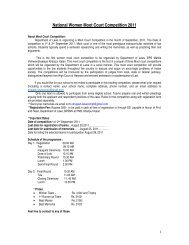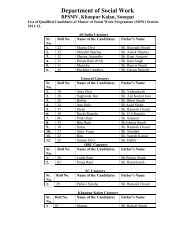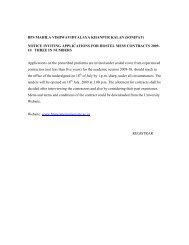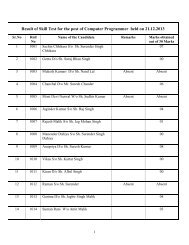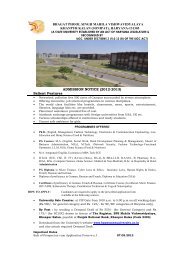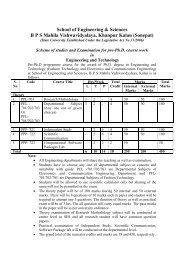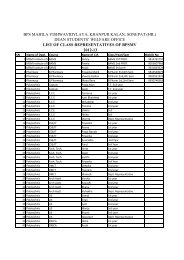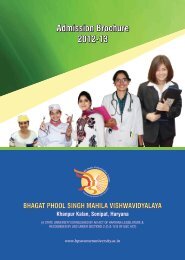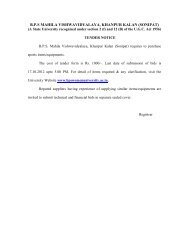Ordinance and Syllabus - Bhagat Phool Singh Mahila ...
Ordinance and Syllabus - Bhagat Phool Singh Mahila ...
Ordinance and Syllabus - Bhagat Phool Singh Mahila ...
Create successful ePaper yourself
Turn your PDF publications into a flip-book with our unique Google optimized e-Paper software.
Paper Code: BPL-202Pharmaceutical Chemistry-V (Pharmaceutical Biochemistry)L -- T -- P Total Credits: 044 -- -- Total Marks: 100External Marks: 50Internal Marks: 50Paper Objectives: Students are taught those areas of biochemistry which are important forthe underst<strong>and</strong>ing of metabolic disorders relevant to common disturbances of body functions,gene structure <strong>and</strong> functions. General introduction <strong>and</strong> basic biochemistry of proteins,carbohydrates, bioenergetics, lipids, etc., including biochemistry of enzymes <strong>and</strong> metabolicfate of nitrogen is also taught. The syllabus also includes replication <strong>and</strong> expression ofgenetic information. Metabolic basis of biochemistry in relation to human metabolism,digestion <strong>and</strong> intestinal absorption are also taught.UNIT IIntroduction: Biochemical organization of the cell <strong>and</strong> transport processes across cellmembrane.The concept of free energy, determination of change in free energy - fromequilibrium constant <strong>and</strong> reduction potential, bioenergetics, production of A TP <strong>and</strong>its biological significance.Enzymes: Nomenclature, enzyme kinetics <strong>and</strong> its mechanism of action, mechanismof inhibition, enzymes <strong>and</strong> iso-enzymes in clinical diagnosis, immobilization ofenzymes. Co-enzymes: Vitamins as co-enzymes <strong>and</strong> their significance. Metals as coenzymes<strong>and</strong> their significance.Carbohydrate Metabolism: Conversion of polysaccharide to glucose-I-phosphate,Glycolysis <strong>and</strong> fermentation <strong>and</strong> their regulation, Gluconeogenesis <strong>and</strong>glycogenolysis, Metabolism of galactose <strong>and</strong> galactosemia, Role of sugar nucleotidesin biosynthesis, <strong>and</strong> Pentosephosphate pathway.UNIT IIThe Citric Acid Cycle: Significance, reactions <strong>and</strong> energetic of the cycle,Amphibolic role of the cycle, <strong>and</strong> Glyoxalic acid cycle.Lipids Metabolism: Oxidation of fatty acids, oxidation & energetic, β-oxidation,Biosynthesis of ketone bodies <strong>and</strong> their utilization. Biosynthesis of saturated <strong>and</strong>unsaturated fatty acids, Control of lipid metabolism, Essential fatty acids &eicosanoids (prostagl<strong>and</strong>ins, thromboxanes <strong>and</strong> leukotrienes), phospholipids, <strong>and</strong>sphingolipids.Biological Oxidation : Redox-potential, enzymes <strong>and</strong> co-enzymes involved inoxidation reduction & its control, The respiratory chain, its role in energy capture <strong>and</strong>its control, Energetics of oxidative phosphorylation, Inhibitors of respiratory chain<strong>and</strong> oxidative phosphorylation, Mechanism of oxidative phosphorylation.UNIT IIINitrogen & Sulphur Cycle: Nitrogen fixation. ammonia assimilation, nitrification<strong>and</strong> nitrate assimilation, Sulphate activation. sulphate reduction. Incorporation ofsulphur in organic compounds, Release of sulphur from organic compounds.61



